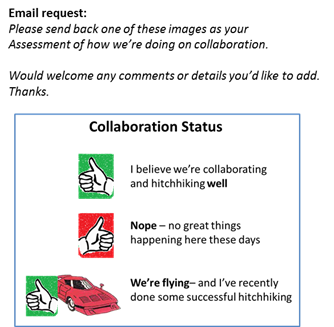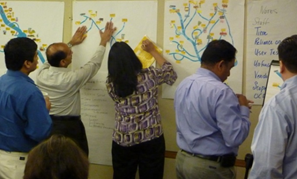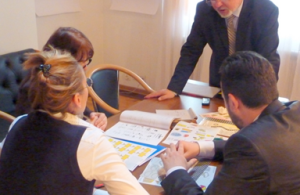Catalyze Collaboration!
A new training offering
For teaming at the highest level
COLLABORATION
Definition
Collaboration is building ideas, collectively.
It’s execution on those ideas with common purpose and ownership.
Each person leads when their strengths are called for and supports others.
Collaboration skill is uniquely valuable when there’s no leader to set direction or resolve differences.
Think of collaboration as a composer and lyricist doing the creative work to make a hit record.
Think of a larger team with mixed goals, say engineering or business development,
where it’s even more complicated to get the words and music right
Collaboration skill enables fruitful partnerships across organizations.
The Offering
This action-learning class emphasizes “hitchhiking” on each other’s ideas
Your team builds skill while mapping their vision and strategy or other topic
We deliver the class or train your trainer
1. Collaboration topics
Personal skills
Structures for collaborating
Engendering collaborative behaviors
How visualization promotes innovation
2. What’s unique about “Catalyze Collaboration!”?
Its focus on “Hitchhiking”
This class assumes the participating team already possesses basic teamwork skills. Its focus is on “hitch hiking”, the most critical skill and best measure of collaboration. Team members apply their differing perspectives to building new ideas on to better serve or attract customers. Hitchhiking is taught, practiced, measured, discussed and practiced again. When a cross-organization team exits the class, they know how to hitch hike. They know how to collaborate
Applied collaboration
High participant engagement is assured by action-learning on one of participants’ core issues, typically building a vision and strategy for the coming year. It readies the team for the many new structures coming into place in today’s interconnected world for addressing new needs and for profit:
- Cross-functional teams within an organization: Supply chains, Research/Development/Marketing
- Value chain partnership with suppliers, customers
- Merger of strengths with (non)-competitors: Apple-IBM for ease of access to deep data
- Strength leveraging by extending into related fields: Natural History Museum invests in partnerships for new areas of scientific research
- New disciplines: Astro-Biology, Darwinian Medicine
Participants learn to employ “collaborative visual systems thinking”
“Collaborative visual systems thinking” is a mouthful— But, it’s also a capability well worth mastering. Following discussion of teamwork and collaboration principles, all participants focus their experience and capability of the on the challenging issue they brought to the class. They usually choose to build a future vision and strategy for achieving it. The visual methods described below ensure the “mental models” each member has are clear to others. They “hitch hike” on each others ideas until they’ve solved the issue. “Hitch hiking” is widely visible in Mapping sessions and is a visible indicator of collaborative behavior.
Visual tools in a high-energy classroom
The Metaphor Mapping process is known for establishing a safe, open stimulating environment. It encourages participants to practice the skills and behaviors taught. Stickers of familiar objects within metaphors become a language for collaborative and disciplined work sessions. For example, participants portray their ongoing operational activity as a village with houses, roads, storm clouds, swamps and fallen trees having specific meaning. They may show values that dominate the village and aspects of the environment, such as a prison of old ideas or a volcano that risks changing the landscape. Participants build their strategy as a river flowing through time—actions they will take plus sand bars, hidden rocks and crocodiles. The method leads them to consider assistance needed to overcome obstacles and possible undesirable outcomes if they take a wrong turn. Responsibilities are powerfully stated when team members assign roles with images.
The sticker symbols help group members warm to their collaborative task, understand each other and work together readily regardless of prior tensions. The “serious play” of mapping a big picture vision or strategy opens participants to new ways of thinking and draws out everyone’s best ideas. Those ideas are eventually owned by all when symbol after symbol is added to the map. There’s no question of “buying in” to the vision and strategy. They built it together and own it together.
Material taught in this course draws on industry literature best practices, action-learning techniques applied worldwide and additional visual techniques described in the ASQC book Reinventing Communication
and the ebook Leading from the Middle – Collaboration through Metaphors
They can be read or downloaded at no charge from the links above.
3. Class outline
Advance preparation:
- Identify a team related issue for action-learning. An operational vision and strategy to achieve it are the most frequently chosen
Half day class:
- Introduction to collaboration principles
- Build collaborative map of today’s state of the team’s area of interest
- Build a collaborative vision
- Review collaboration principles
One day class:
- Introduction to collaboration principles
- Build collaborative map of today’s state of the team’s area of interest
- Build a collaborative vision
- Build a strategy, with focus on overcoming obstacles
- Review collaboration principles
One and a half day class:
- Introduction to collaboration principles
- Build collaborative map of today’s state of the team’s area of interest
- Build a collaborative vision
- Build a strategy, with focus on overcoming obstacles
- Build visual/symbolic grid of roles/responsibilities
- Address attitudes and behaviors with visual symbols
- Review collaboration principles

4. Value to participants
- Understand the theory and gain experience applying collaboration principles that have been proven in over 400 sessions and over 30 countries
- Increased understanding of teammates’ perspectives
- Learn and deepen relationships through analyzing the team’s current operation and creating a shared vision
- Participants in full day and longer courses learn to build a shared strategy, establish roles and responsibilities in a visual way, deal with sometimes hidden attitudes and behaviors
- Facilitator/trainer is an international consultant and experienced executive at major corporations
5. Value to the greater organization and the training department
- Action-learning on a skill of critical importance to organization effectiveness
- Immediate benefits of an agreed vision and strategy for participating teams
- An easy-to-administer survey is included to measure how well the skills “stick” in the organization over time
- How do you measure your team’s collaboration skill?The single best indicator of effective collaboration taking place is the perception whether people are “hitch hiking” on each other’s ideas. This is high-leverage indicator because hitch hiking requires voluntary engagement, effective communication, mutual trust and respect, openness to new ideas, a creative environment, and results the the joint ownership that will ensure a drive to implement. Simply Email out a survey with visual indicators.

6. “Catalyze Collaboration!” pricing
Half day training for 12 to 24
Full day
One and half days
Train the trainer







